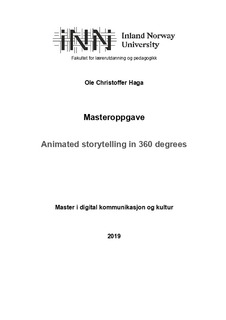| dc.description.abstract | This Master thesis is examining how film form and film style is utilized to tell stories within VR movies; animated shorts aimed at screening through head mounted displays (HMD). Mainly, these shorts have a linear narrative, but simultaneously leave some decisions to the spectator, e.g. where to turn their head at any moment, consequently leaving the framing of shots to the audience. Since they all have a certain degree of interactivity, these productions have inherited features from both movies and games. Thus, the theoretical basis will include works from both academic fields. The objective is to study what parts of film form and film style are still applicable within a ubiquitous 360-degrees view. I will also study how the potential sense of immersion and spatial presence achieved by the 360-degrees view influences the narration. The thesis is conducted as a qualitative analysis of the following study objects:
Fan, M. (Producer) & Darnell, E. (Director). (2016). Invasion! [Animated short for 360 degrees screening]. USA: Baobab Studios.
Eisenmann, D. (Producer) & Osborne, P. (Director). (2016). Pearl. [Animated short for 360 degrees screening]. USA: Evil Eye Pictures.
Cellucci, C. (Producer), Pinkava, J. (Director) & Oftedal, M. (Director). (2018). Piggy. [Animated short for 360 degrees screening]. USA: Google Spotlight Stories.
The first selection, Invasion! (Fan & Darnell, 2016), is one of the earliest attempts of transferring animated movies into HMDs, and in this one the spectator additionally is granted with an avatar. The second selection, Pearl (Eisenmann & Osborne, 2016) is considered a milestone within the medium as the first 360 animated short (and the only one till this date) to receive a nomination for an Academy Award. The final selection, Piggy (Cellucci, Pinkava & Oftedal, 2018) includes narrative elements proceeding in real time, and the pacing and order of events can thus partly be influenced by where the spectator is turning their gaze.
Under the headlines Film Form, Film Style and Immersion/Presence, I will examine how a ubiquitous visual display affects the way a narrative pattern (film form) is constructed, and how the technical and aesthetic devices (film style) are utilized to convey this pattern. Finally, I will look at whether these movies are able to give a sense of immersion/presence and how this might influence the narrative. | nb_NO |
